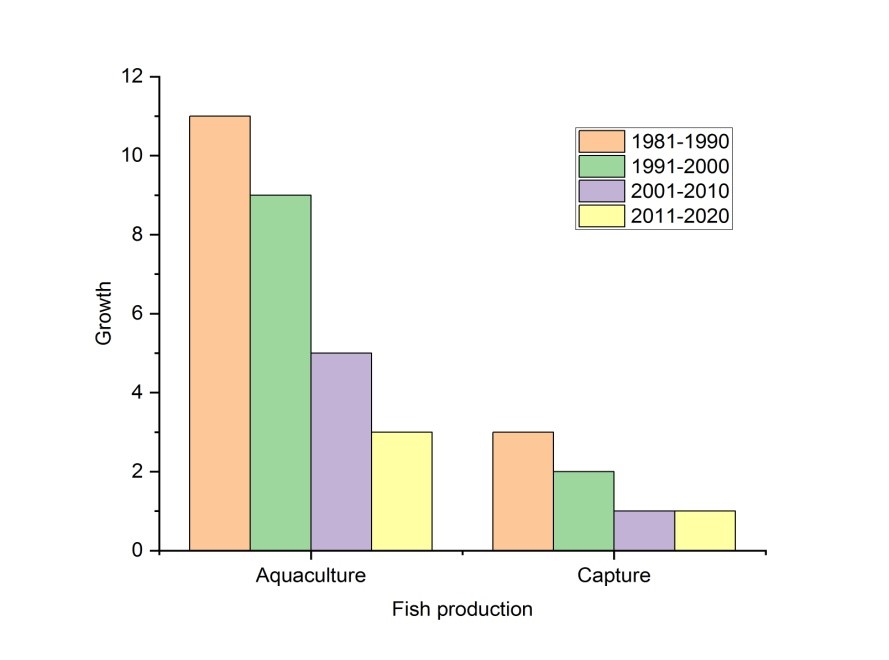The Role of Genetics in Fish Breeding and Its Impact on Production and Meat Quality
Abstract
Over the past 25 years, advances in biotechnology have enabled scientists to create animals that have been genetically modified (GM) for use in agriculture and medicine. The bulk of GM fish and animals are still in the research stage. In order to produce high-quality fish stocks and satisfy the rising worldwide demand for seafood, fish breeding is essential to the aquaculture sector. The business has undergone a revolution because to the use of genetics in fish breeding, which has improved desired features including growth rate, illness resistance, and environmental adaptation. The concepts and uses of genetics in fish breeding are summarized with an emphasis on the main methods and tactics used to accomplish the desired genetic advancements. Understanding genetic diversity, heritability, and connections is essential to understanding the principles of fish breeding. Breeders can find people with better features by using genetic variation as the foundation for selection. Heritability calculates the percentage of phenotypic diversity under the control of genes and sheds light on the possibility of genetic advancement. Breeders can better grasp the connections between various features and the likelihood of simultaneous selection using genetic correlations.
References
Chu, Y.I., Wang, C.M., Park, J.C. and Lader, P.F., 2020. Review of cage and containment tank designs for offshore fish farming. Aquaculture, 519, p.734928.
Besson, M., Komen, H., Rose, G. and Vandeputte, M., 2020. The genetic correlation between feed conversion ratio and growth rate affects the design of a breeding program for more sustainable fish production. Genetics Selection Evolution, 52, pp.1-10.
Komolka, K., Bochert, R., Franz, G.P., Kaya, Y., Pfuhl, R. and Grunow, B., 2020. Determination and comparison of physical meat quality parameters of percidae and salmonidae in aquaculture. Foods, 9(4), p.388.
Arnaudova, M., Brunner, T.A. and Götze, F., 2022. Examination of students' willingness to change behaviour regarding meat consumption. Meat Science, 184, p.108695.
Kong, W., Huang, S., Yang, Z., Shi, F., Feng, Y. and Khatoon, Z., 2020. Fish feed quality is a key factor in impacting aquaculture water environment: evidence from incubator experiments. Scientific reports, 10(1), p.187.
Kang, B., Vitule, J.R., Li, S., Shuai, F., Huang, L., Huang, X., Fang, J., Shi, X., Zhu, Y., Xu, D. and Yan, Y., 2023. Introduction of non‐native fish for aquaculture in China: A systematic review. Reviews in Aquaculture, 15(2), pp.676-703.
Baldissera, M.D., Souza, C.F., Zeppenfeld, C.C., Velho, M.C., Klein, B., Abbad, L.B., Ourique, A.F., Wagner, R., Da Silva, A.S. and Baldisserotto, B., 2020. Dietary supplementation with nerolidol nanospheres improves growth, antioxidant status and fillet fatty acid profiles in Nile tilapia: Benefits of nanotechnology for fish health and meat quality. Aquaculture, 516, p.734635.
Lhorente, J.P., Araneda, M., Neira, R. and Yáñez, J.M., 2019. Advances in genetic improvement for salmon and trout aquaculture: the Chilean situation and prospects. Reviews in Aquaculture, 11(2), pp.340-353.
Ahmadifar, E., Pourmohammadi Fallah, H., Yousefi, M., Dawood, M.A., Hoseinifar, S.H., Adineh, H., Yilmaz, S., Paolucci, M. and Doan, H.V., 2021. The gene regulatory roles of herbal extracts on the growth, immune system, and reproduction of fish. Animals, 11(8), p.2167.
D’ambrosio, J., Phocas, F., Haffray, P., Bestin, A., Brard-Fudulea, S., Poncet, C., Quillet, E., Dechamp, N., Fraslin, C., Charles, M. and Dupont-Nivet, M., 2019. Genome-wide estimates of genetic diversity, inbreeding and effective size of experimental and commercial rainbow trout lines undergoing selective breeding. Genetics Selection Evolution, 51(1), pp.1-15.
Judycka, S., Nynca, J. and Ciereszko, A., 2019. Opportunities and challenges related to the implementation of sperm cryopreservation into breeding of salmonid fishes. Theriogenology, 132, pp.12-21.
Hang, L., Ullah, I. and Kim, D.H., 2020. A secure fish farm platform based on blockchain for agriculture data integrity. Computers and Electronics in Agriculture, 170, p.105251.
Moniruzzaman, M. and Min, T., 2020. Curcumin, curcumin nanoparticles and curcumin nanospheres: A review on their pharmacodynamics based on monogastric farm animal, poultry and fish nutrition. Pharmaceutics, 12(5), p.447.
Zaukuu, J.L.Z., Bazar, G., Gillay, Z. and Kovacs, Z., 2020. Emerging trends of advanced sensor based instruments for meat, poultry and fish quality–a review. Critical Reviews in Food Science and Nutrition, 60(20), pp.3443-3460.
Calanche, J.B., Beltran, J.A. and Hernandez Arias, A.J., 2020. Aquaculture and sensometrics: The need to evaluate sensory attributes and the consumers’ preferences. Reviews in Aquaculture, 12(2), pp.805-821.







